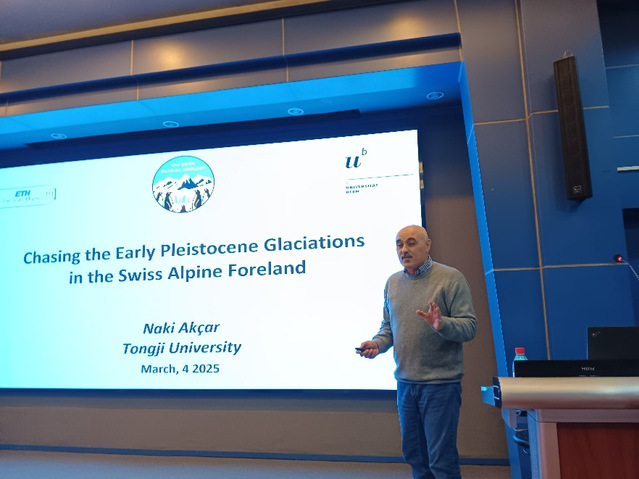Recently, at the invitation of Professor Liu Zhifei and Associate Professor Deng Kai from the State Key Laboratory of Marine Geology, Professor Naki Akçar from the University of Bern, Switzerland, visited the School of Ocean and Earth Science and delivered a seminar.
Professor Akçar heads the Glacial Geology Research Team at the University of Bern’s Institute of Geological Sciences. His research focuses on Quaternary-period interactions among geophysical processes, climate change, and human societies. By analyzing geological records, his team reconstructs sediment production, transport, and deposition timelines to understand past landscape evolution and predict future trends. His work primarily employs cosmogenic nuclide dating (e.g., ¹⁰Be and ²⁶Al) to determine geological ages and landscape evolution rates, with key study regions including the Alps, Scandinavia, Turkey, Ethiopia, and Antarctica.

On March 4, Professor Akçar presented a seminar titled “Chasing the Early Pleistocene Glaciations in the Swiss Alpine Foreland” to faculty and students. His talk focused on Early Pleistocene glaciations in the Alps, particularly the analysis of glacial-fluvial deposits called “Deckenschotter” to unravel sedimentary history and paleoenvironmental changes. These deposits, preserved as terrace-like hills, serve as critical stratigraphic markers for reconstructing past landscape dynamics and climate interactions.
Using cosmogenic nuclide dating (¹⁰Be and ²⁶Al), Professor Akçar’s team established a refined chronology for sediment deposition, identifying three major phases between approximately 3 and 1 million years ago. Their findings offer new insights into glacial advances, river evolution, and sediment transport pathways. The study also reveals complex sequences of sediment incision and refill, challenging earlier stratigraphic interpretations. This improved chronology enhances our understanding of how Alpine glaciations responded to global climatic transitions.
Following the seminar, Professor Akçar toured the Deep-Sea Science Museum and held in-depth discussions with faculty members about potential collaborations, fostering further scientific exchange in this field.
Written by: Xinran Li


